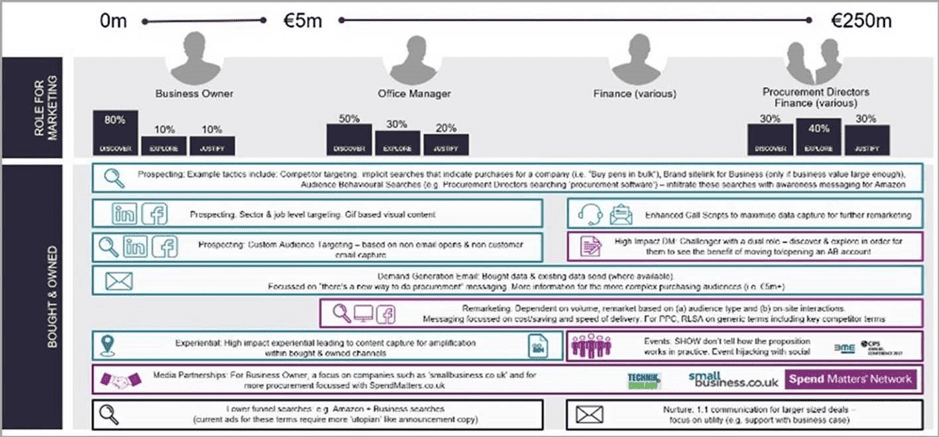Three Go-to-Market models to help you strategize, plan and deliver
Business and marketing go-to-market strategy is an essential component in the delivery of any successful product, service, or promotional launch/campaign.
We’ve written extensively at Smart Insights about the importance of defining a target audience, producing a clear value proposition and optimizing the right marketing mix; just three elements of good marketing strategy to help ensure brands create a competitive advantage, deliver value for customers and generate profit for the business.
However, the success of any strategy is dependent on how this is ultimately executed and within this post, I’d like to look at a few different ways this can be brought to life as part of a Go-to-Market (GTM) plan.
Download our Premium Resource – Business marketing plan guide
A marketing plan provides focus, defines the approaches to grow your market share, expand products or move into new markets and ensures you are on track.
Access the Business marketing plan guide
Defining a GTM plan
There are a number of ways to define a GTM plan and it’s fair to say that this can be interpreted differently by individuals, companies and industries. Some define a GTM plan in a very similar way to that of a business plan, albeit with a narrower, more marketing-centric focus. Others see a GTM plan as the overall strategy for a specific product or service, incorporating some of the elements outlined at the beginning of this posts, e.g. defining a target market, value proposition, marketing mix etc.
For the purpose of this post, I’m going to refer to a GTM plan in a more tactical, executional way.
It’s an action plan constructed to demonstrate to stakeholders, managers and clients what happens next after the overarching strategy has been signed off. A GTM plan can be useful at various different stages in the strategy -> execution process and, therefore, one of the skills marketers must possess is the ability to choose the right GTM plan for the right moment.
Looking for a winning marketing strategy?
Whether you're launching your first product, planning a new line, or repositioning an existing portfolio, you need an omnichannel marketing strategy that attracts and retains your target market.
That's why we recommend the RACE Framework, for marketers looking to optimize their product marketing through a data-driven, customer-centric approach. Structured across your customers' experiences of your product, from hearing of the product for the first time right through to repeat purchase and advocacy, the RACE Framework helps you manage customer journeys.

You can use the RACE Framework to identify opportunities and challenges in your GTM strategy. Book a free 1-2-1 consultation with the team to discuss your marketing strategy in the context of RACE, and find marketing solutions to help you win more customers. Book your call to find out more. Need a winning marketing strategy?
Book your free 1-2-1 consultation to develop your new strategy with the RACE Framework
Book consultation
Choosing the right GTM plan approach
A good GTM plan will be aligned to one of the three different stages in the planning cycle of a campaign or strategy:
- Strategy
- Plan
- Deliver
You may be at the early stages of formalizing an annual marketing plan, at which point a more high-level, holistic view of channels and outputs might be appropriate. On the other hand, you may be at the sharp end of a campaign with a requirement to produce a more detailed action plan.
Go-to-market strategy
At the ‘Strategy’ stage senior stakeholders or clients will be looking for a top-level view of how the campaign plan will be approached. This will involve a breakdown of different channels, ballpark spend and general audience personas aligned to different media type (i.e. paid, owned, earned):

Precise details on how each channel will be used (e.g. Facebook vs. LinkedIn), timings and media spend is not required - just an overall guide to add another layer of nuance to support the overall strategy.
Go-to-market plan
Once the strategy has been agreed and signed off you’ll go into the next level of detail about the shape and complexion of the campaign or program. This stage will involve details to enable the client or campaign team to start initial media planning and budget allocation. Key areas of focus include:
- Formats
- Flighting
- Content
- Landing pages
- Measures of success
This type of plan will often be built by a combination of an agency planning and digital team, usually within a media agency, although creative agencies may also produce something to demonstrate how their different ideas will be executed across channels and media:

As with all three types of GTM plans, media type (paid, owned, earned) will frame the plan and align back to the overall strategy to ensure consistency.
Go-to-market deliver
The ‘Deliver’ stage is where we can start putting together the most detailed type of GTM plan, allowing us to zoom in on all the specific elements we saw in the ‘Plan’ stage.
It’s common practice to look at each channel in precise detail (separate plans for paid search, paid social, display etc.) so that those running the overall campaign have a clear view of exactly how each elements will be executed. This is important so that media and creative can be signed off and bought.
The example below shows a paid search campaign, broken down into campaigns, ad groups and keyword recommendations. This will also incorporate expected impressions, clicks and results (e.g. conversions, % of video viewed etc. depending on the metric of success):

Due to the specific level of information required, these types of detailed GTM plans are often produced exclusively by media agencies or in-house teams responsible for media spend but it’s useful to have knowledge and experience of this type of planning so you can discuss and integrate ideas and recommendations.
Conclusion
An effective GTM plan will enable you to take a strategy or big idea and turn it into an action plan that highlights key details, including objectives, funnel stage (Reach, Act, Convert), content, channels, and measures.
A GTM plan is where you transition from high-level thinking to a detailed roadmap that brings the campaign, product launch or program to life. While some plans will be very detailed, looking specifically at certain channels such as paid social, search or display, others can be used to support the wider strategy. However, the characteristic that all GTM plans share is the necessary level of detail to enables marketers to take action and make the activity go live.
Start optimizing your go-to-market plan with the RACE Framework. Book on your free 1-2-1 consultation call to discuss your marketing strategy with an expert today Need a winning marketing strategy?
Book your free 1-2-1 consultation to develop your new strategy with the RACE Framework
Book consultation













